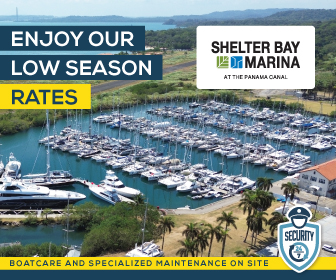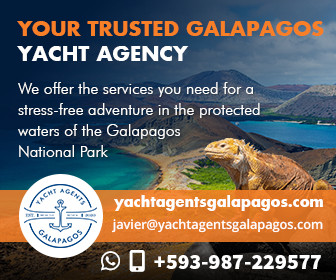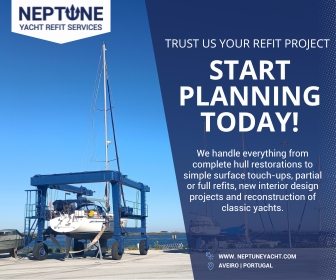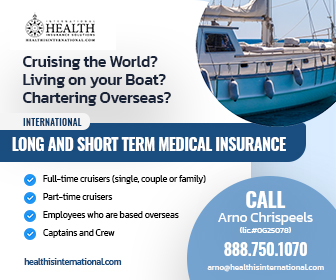Atlantic: Anatomy of a Disaster
In June 2022, Skipper Ingo Patalla was sailing his much-loved yacht Faule Haut from Miami, Florida to the Azores, when the boat was capsized and sunk by a tropical cyclone. Here, he shares his story of what happened and how he and his crew were rescued by the US Coast Guard.
Published 3 years ago

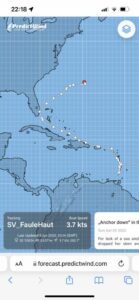
- The final resting place of Faule Haut.
Faule Haut is dead. She capsized in a tropical cyclone between Florida and the Bermudas on June 5th, 2022, in the middle of the night when she got hit by a monster wave.
The US Coast Guard (USCG) rescued us by helicopter on June 6, 2022 at around noon 250 nm west of the Bermudas. The beloved sailing vessel (my home during the last five years) Faule Haut is dead. She should be lying on the seabed by now. You cannot imagine my mood and condition. I sailed with her around the world and a lot more. We were together for about 90,000 nm during a period of five years.
Question: What led to this disaster of Faule Haut?
Answer: It was a bad weather prediction combined with bad luck.
To make my cruising safer, six months ago, I installed a satellite system on board with the Predictwind software to be able to see the forecast.
While we were cruising from Miami to the Azores, I downloaded the weather constantly every day and checked and adjusted our course.
You can read on my tracking page that I saw a tropical cyclone heading our way – not exactly our way, but too close to us. The forecast predicted that the southern edge of the cyclone would pass north of us if we kept on our track.
Change of Course for Us
I didn’t want to come that close to this cyclone and changed my course more southerly. On the tracking page I wrote +19° (from 66° to 85°). In reality I changed it slightly more, about 22 or 23°. The course of that tropical cyclone was predicted to pass north of the Bermuda Islands.
Our course initially was north of the islands as well – now we were heading for a point that we pass Bermuda south. The prediction also said the Cyclone would move with a speed of 15 knots, turning left, more northerly, moving away from us.
I checked the weather every few hours, but when I downloaded the new forecast, that program says “next weather download available in ten hours”. So Predictwind puts the new data in after 10 hours. That period is too long.
Change of Course for the Cyclone
When I downloaded the weather after 10 hours I saw that the cyclone had changed its course more easterly (instead of turning northerly like predicted) and was following us. You can read that on the blog of my tracking page.
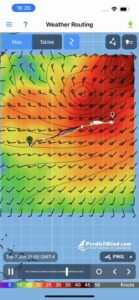

From the next weather forecast I don’t have a screen shot made, but it showed that the cyclone has changed its course from east-north-east more to east. (Also written on the blog). It has been following us and we were in it. Winds hit the 50 kn mark and we were unable to keep the sails up. We took them down and we were drifting with the wind, unable to steer, being pushed north. In addition, the forecast on the picture showed a wind speed of 25 knots, maybe maximum 30 knots. But not the 50+ that we experienced later. Even at the point close to the center you find the highest speed to be 35 to 40 knots. Even the next prediction never showed wind speed over 40 knots (except close to the very center).
Rocking and Rolling
We had strong waves and got winds up to 50 knots. I had seen worse before that and still was not too worried. We had all the sails down and were drifting on the ocean. This went well for hours, maybe six or seven, and we sat in our berths. The boat was rocking and rolling in high winds and waves, but not in such a manner to rise any fear. Waves were high, but not breaking.
But then, without any warning, in the middle of the night, a wave hit the port side.
Indescribable
It sounded and felt like three trucks ramming into you at the same time. I thought FH was falling apart, shattered into a thousand pieces. I had read about “monster waves” and “freak waves” before. Now I know they exist.
Water shot in the boat from every open or broken window and through the companionway whose door and sliding door were crashed and gone. But at the same time she went around, 360° to the left. We capsized right through. A full turn. The rotation was extremely fast, probably took less than three seconds. I flew against the ceiling and back onto my bunk. And then the entire contents of what I had stowed under the bunk fell on me. The three batteries (3×65 kg) were torn out of place and their fixings and two of them were on the floor in front of my bunk. Lucky, that none of the 65 kg hit me.
My door had been blown away and was floating in the saloon. My American friend, whose door was also blown off, was hit in the head and suffered a laceration above the eye, fortunately it was not too serious. It could also be that he was hit by the wall between the bunk and the engine room. That wall got kicked out too. Naturally, the deck was under water during the turn and it shot through all three windows into my bunk. The closed window above the navigation table was also blown out. We ran out and I thought I had to throw out the life raft immediately. I was glad that at least this, was still there.
Our mast was gone. Three solar panels had flown away, the entire stainless steel rack for the solar panels was cracked and bent. Also the pushpit and pulpit. Sprayhood completely flown away. Windows knocked out. Boom lay on the deck. Handrails, starboard and port, on which I had tied my spare set of sails, genoa, main and another hank on genoa for my second forestay, were blown away with all the sails together.
The acrylic door to the companion way was shattered and its sliding door over the entrance was missing, blown away. But to my astonishment the boat was still buoyant. Immediately I activated my EPIRB.

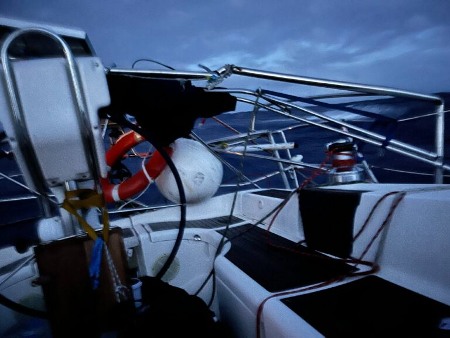
- Solar panels blown away.
A Battlefield Inside
The boat looked like a battlefield inside. My sea radio, which was so important to have now, had flown off the shelf and was nowhere to be found. Two of my house bank (3) batteries were on the floor in front of my bed. One was torn off of the connecting cables, the other two were still attached. The starter battery had blown out of its place under the stairway (access to the motor, was open) and was lying next to it. The engine compartment was open. Yet amazingly, we still had electrical power. I made several mayday calls from the solid installed marine radio, but never received an answer. I don’t know if anyone heard me. It was not very likely because the mast on which the antenna sits was hanging vertically down in the water. Without an antenna I only have a very limited range.

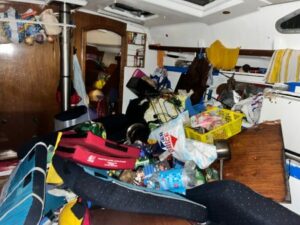
- Everything messed up in the salon.

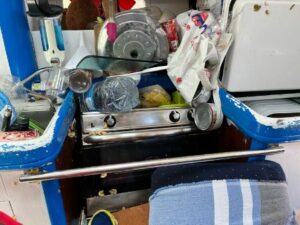
- Stove/oven torn out.
I went through hell for 40 minutes to find the mobile marine radio which was of such great importance. You can’t imagine what it looks like, when a boat capsizes, when it makes a roll, 360°. Of course, all the floorboards were thrown out. The entire contents of the bilge, spare parts of all kind, tools, along with the contents of the saloon’s and pantry’s shelves mingled, floated on the floor in the water. Table and benches were torn from their fixings or broken. The wall between bunk and engine compartment blown out.
After 40 minutes I finally found the mobile marine radio. Glad I had bought a waterproof one for it was floating in the water in the bilge under all the trash. Haven’t used it for some time, but I charged it regularly. Luckily, the battery was still more than half full.
Then I made several Mayday calls with this handheld and made my position known. Finally I got got a response from the US Coast Guard (USCG). What a relief this was. Now I was confident that we’d get saved. They said the nearest ship was nine hours away.
Nine Anxious Hours
Nine anxious hours lay ahead of us with the possibility that a wave of the same kind could hit the boat again. My two American friends sat leashed in the cockpit. I was busy packing bags full of food for the life raft. A little later the USCG told us that a tanker would be with us in five hours. Because my marine radio only had limited battery power, I agreed with them that I would give a report every full hour or in case anything unusual happened.
In the meantime it could be seen that the boat was only taking on a small amount of water and would probably still be able to float for several hours. Nevertheless, I prepared our transfer to the life raft. There could be another monster wave coming. I packed food in bags, lots of canned food, cereal bowls and everything you need in a situation like this, cutlery, especially the can opener, would have been important, but couldn’t find it anywhere because the cutlery drawer was gone. Everything was floating in the bilge.
Then after five hours we saw the tanker (“Aegean Harmony”) on the horizon. Their captain communicated with the USCG and us. He said he couldn’t and wouldn’t try to get us over to his boat (yet). He considered that too great a risk, and I could only agree with him.

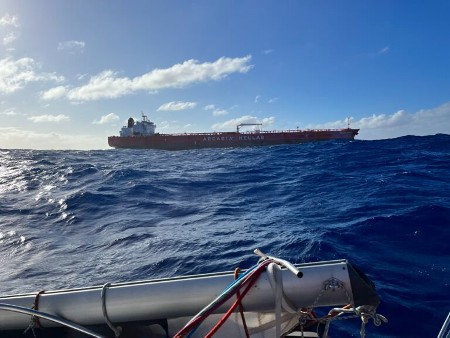
- First boat to help – Aegean Harmony.
Violent Wind and Waves
Wind and waves were too violent. Only in case our boat would start sinking fast. I estimated its freeboard to be between 8 and 10 m high. They would have had to let ropes down to get us up. How would he place his boat close to mine? His boat has a turning circle of close to a mile. He would have to make a long turning circle aiming at FH to get close. With his huge turning circle he would have to aim almost directly towards us for the rescue. We were unable to manoeuvre.
Our rudder must also have been damaged by the blast because it didn’t work. In those high waves and wind conditions, Faule Haut would probably be smashed against the tanker’s steel hull with every wave. And jumping into the water, in waves like this would have been a risk. If you can’t swim against the waves to reach the tanker, you’re doomed. We hoped, that the tanker would have a dinghy but it didn’t. However, the captain told us that he would stay with us until another boat picked us up and circled around us for four hours. Thanks a lot to the captain of Aegean Harmony.
US Coast Guard to the Rescue

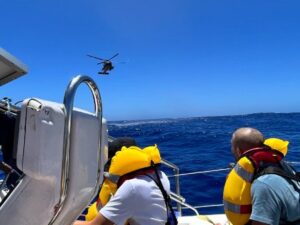
- Awaiting the order to jump.
On my next contact with the USCG, they told us that other boats were too far away and that they would rescue us by helicopter which would be with us in less than four hours. It showed up like they said and one of the four guys on board gave us instructions about the rescue procedures. They told us we were only allowed to bring our passports, no bags, nothing else. We argued shortly with them and were allowed to jump in with a tiny bag, only little stuff that we still are able to swim with in those strong waves.
I had been living on my boat for over four years. I had to leave a lot of things that meant a lot to me on the boat. My two American friends got pulled up first. We had to jump into the water one by one with our life jacked pre-activated. A diver was roped down, swam towards us and put the rescue sling under our arms, connected it to the rope hanging down from the copter and we were pulled up in turn.

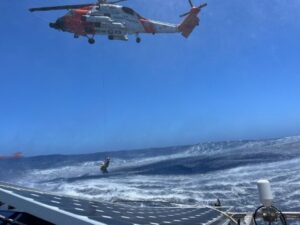
- Second lift to safety.
Then we headed towards a US aircraft carrier (about 150 nm) where the helicopter had to refuel. We were allowed to get out and go inside the aircraft carrier. Amazingly, there were almost only young guys and girls working and we had to tell them our rescue story. We also got a hot meal that we could eat in the copter. They flew us to their base in North Carolina. Another three hours flight time.
Finally on Dry Land
Five hours after the rescue we were finally on the base, chilled and emaciated after a night without sleep and five hours of freezing in the copter in our wet clothes.
At the base we got new dry t-shirts, flip flops and pants. And – listen and be amazed – everyone got a credit card with which we could pay a hotel room, food and even new clothes. They knew we had lost everything, nothing to wear and with their credit card we were allowed to get new basic clothes.
A Professionally Executed Rescue Operation
Amazing how professional the rescue operation was executed by the USCG, and how generous and outspoken they are helping. We had breakfast the next morning at the International House of Pancakes (IHOP) and then went to the clothing store and got new clothes.
However, I have excruciating pain on my right side. When we capsized, I hit the ceiling or one of the batteries fell on my side. Don’t know what it was. Most likely I got one or two broken ribs. But broken ribs heal on their own. You don’t need to do anything there. USCG has asked us several times if we got hurt or need medical help. I didn’t say anything about it. I just wanted to go and sleep. I was totally worn out.
Thanks to our brave heroes, the USCG (US Coast Guard). They did such a professional job. Great guys all four. It was risky for them as for us in a storm like that. These guys risk their lives daily to save others. What a job they have. Their base covers a huge area. One of them told us that they do (average) one rescue operation daily, be it in the mountains or on the water, and that they often get back to their base without anybody. The more glad I was, that they landed with us at their base at North Carolina.

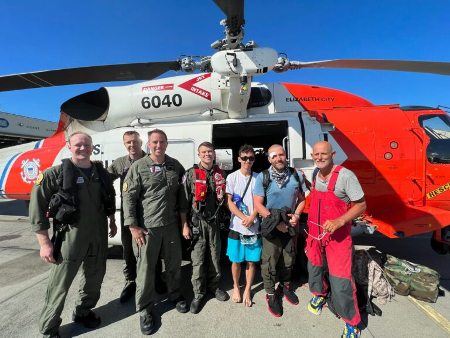
- Thank you USCG. Perfect job done.
Life Goes On
Faule Haut is dead. I have been a live-aboard on and with her for over five years. I enjoyed every minute. The loss is hard to bear, but I’m happy to be alive. Life goes on and I’m positive.
Ingo Patalla
former skipper of SV Faule Haut.
……………………………………………………………………………………………………………………………………….
About the Author:
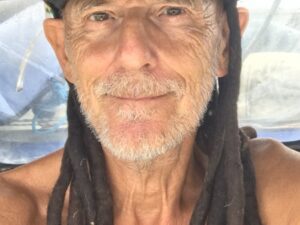

He has written about his adventures on his Faule Haut – The Circumnavigation website.
……………………………………………………………………………………………………………………………………….
The opinions expressed in this article are the author’s own and do not reflect the view of Noonsite.com or World Cruising Club.
Related to the following Cruising Resources: Weather


